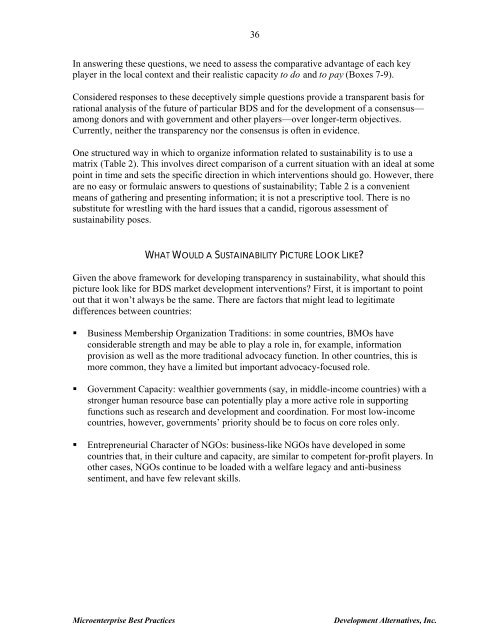BDS market development guide.pdf - PACA
BDS market development guide.pdf - PACA
BDS market development guide.pdf - PACA
You also want an ePaper? Increase the reach of your titles
YUMPU automatically turns print PDFs into web optimized ePapers that Google loves.
36<br />
In answering these questions, we need to assess the comparative advantage of each key<br />
player in the local context and their realistic capacity to do and to pay (Boxes 7-9).<br />
Considered responses to these deceptively simple questions provide a transparent basis for<br />
rational analysis of the future of particular <strong>BDS</strong> and for the <strong>development</strong> of a consensus—<br />
among donors and with government and other players—over longer-term objectives.<br />
Currently, neither the transparency nor the consensus is often in evidence.<br />
One structured way in which to organize information related to sustainability is to use a<br />
matrix (Table 2). This involves direct comparison of a current situation with an ideal at some<br />
point in time and sets the specific direction in which interventions should go. However, there<br />
are no easy or formulaic answers to questions of sustainability; Table 2 is a convenient<br />
means of gathering and presenting information; it is not a prescriptive tool. There is no<br />
substitute for wrestling with the hard issues that a candid, rigorous assessment of<br />
sustainability poses.<br />
WHAT WOULD A SUSTAINABILITY PICTURE LOOK LIKE?<br />
Given the above framework for developing transparency in sustainability, what should this<br />
picture look like for <strong>BDS</strong> <strong>market</strong> <strong>development</strong> interventions? First, it is important to point<br />
out that it won’t always be the same. There are factors that might lead to legitimate<br />
differences between countries:<br />
• Business Membership Organization Traditions: in some countries, BMOs have<br />
considerable strength and may be able to play a role in, for example, information<br />
provision as well as the more traditional advocacy function. In other countries, this is<br />
more common, they have a limited but important advocacy-focused role.<br />
• Government Capacity: wealthier governments (say, in middle-income countries) with a<br />
stronger human resource base can potentially play a more active role in supporting<br />
functions such as research and <strong>development</strong> and coordination. For most low-income<br />
countries, however, governments’ priority should be to focus on core roles only.<br />
• Entrepreneurial Character of NGOs: business-like NGOs have developed in some<br />
countries that, in their culture and capacity, are similar to competent for-profit players. In<br />
other cases, NGOs continue to be loaded with a welfare legacy and anti-business<br />
sentiment, and have few relevant skills.<br />
Microenterprise Best Practices<br />
Development Alternatives, Inc.














